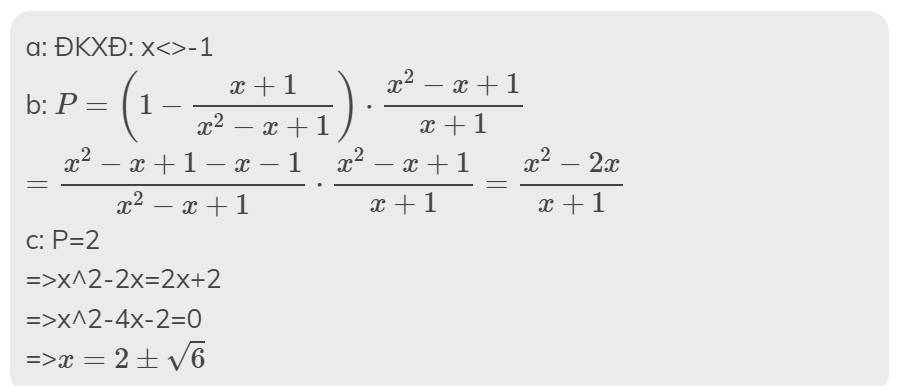Tìm x để biểu thức nhận giá trị nguyên âm : A=\(\dfrac{x-2}{x+1}\)
Hãy nhập câu hỏi của bạn vào đây, nếu là tài khoản VIP, bạn sẽ được ưu tiên trả lời.


a) Ta có: \(M=\dfrac{8x+1}{4x-5}=\dfrac{8x-10+11}{4x-5}=\dfrac{2\left(x-5\right)+11}{4x-5}=2+\dfrac{11}{4x-5}\)
Để M nhận giá trị nguyên thì \(2+\dfrac{11}{4x-5}\) nhận giá trị nguyên
\(\Rightarrow\dfrac{11}{4x-5}\) nhận giá trị nguyên
\(\Rightarrow11⋮4x-5\)
Vì \(x\in Z\) nên \(4x-5\in Z\)
\(\Rightarrow4x-5\inƯ\left(11\right)=\left\{\pm1;\pm11\right\}\)
\(\Rightarrow x\in\left\{1;\pm1,5;4\right\}\)
Vậy \(x\in\left\{1;4\right\}\) thỏa mãn \(x\in Z\).
b) Ta có: \(A=\dfrac{5}{4-x}\). ĐK: \(x\ne4\)
Nếu 4 - x < 0 thì x > 4 \(\Rightarrow A>0\)
4 - x > 0 thì x < 4 \(\Rightarrow A< 0\)
Để A đạt GTLN thì 4 - x là số nguyên dương nhỏ nhất
\(\Rightarrow4-x=1\Rightarrow x=3\)
\(\Rightarrow A=\dfrac{5}{4-3}=5\)
Vậy MaxA = 5 tại x = 3
c) \(B=\dfrac{8-x}{x-3}\). ĐK: \(x\ne3\).
Ta có: \(B=\dfrac{8-x}{x-3}=\dfrac{-\left(x-8\right)}{x-3}=\dfrac{-\left(x-3\right)+5}{x-3}=\dfrac{5}{x-3}-1\)
Để B đạt giá trị nhỏ nhất thì \(\dfrac{5}{x-3}-1\) nhỏ nhất
\(\Rightarrow\dfrac{5}{x-3}\) nhỏ nhất
Nếu x - 3 > 0 thì x > 3 \(\Rightarrow\dfrac{5}{x-3}>0\)
x - 3 < 0 thì x < 3 \(\Rightarrow\dfrac{5}{x-3}< 0\)
Để \(\dfrac{5}{x-3}\) nhỏ nhất thì x - 3 là số nguyên âm lớn nhất
\(\Rightarrow x-3=-1\Rightarrow x=2\)
\(\Rightarrow B=\dfrac{8-2}{2-3}=-6\)
Vậy MaxB = -6 tại x = 2.
Mình làm sai câu a...
Ta có: \(M=\dfrac{8x+1}{4x-1}=\dfrac{8x-2+3}{4x-1}=\dfrac{2\left(4x-1\right)+3}{4x-1}=2+\dfrac{3}{4x-1}\)
Để M nhận giá trị nguyên thì \(2+\dfrac{3}{4x-1}\) nhận giá trị nguyên
\(\Rightarrow\dfrac{3}{4x-1}\) nhận giá trị nguyên
Vì \(4x-1\in Z\) nên \(4x-1\inƯ\left(3\right)=\left\{\pm1;\pm3\right\}\)
\(\Rightarrow x\in\left\{\pm0,5;0;1\right\}\)
Vậy \(x\in\left\{0;1\right\}\) thỏa mãn \(x\in Z\).

a: \(A=\dfrac{x+2+x^2-2x+x-2}{\left(x-2\right)\left(x+2\right)}=\dfrac{x^2}{x^2-4}\)

a: \(A=\dfrac{x+2+x^2-2x+x-2}{\left(x-2\right)\left(x+2\right)}=\dfrac{x^2-2x}{\left(x-2\right)\left(x+2\right)}=\dfrac{x}{x+2}\)

a) \(A=\dfrac{x+2+x^2-2x+1}{\left(x-2\right)\left(x+2\right)}=\dfrac{x^2-x+1}{\left(x-2\right)\left(x+2\right)}\)
a: \(A=\dfrac{x+2+x^2-2x+x-2}{\left(x+2\right)\left(x-2\right)}=\dfrac{x^2}{x^2-4}\)

a)B = \(\dfrac{2x}{x+3}+\dfrac{x+1}{x-3}+\dfrac{7x+3}{9-x^2}\left(ĐK:x\ne\pm3\right)\)
= \(\dfrac{2x}{x+3}+\dfrac{x+1}{x-3}-\dfrac{7x+3}{x^2-9}\)
= \(\dfrac{2x\left(x-3\right)+\left(x+1\right)\left(x+3\right)-7x-3}{\left(x+3\right)\left(x-3\right)}\)
= \(\dfrac{3x^2-9x}{\left(x+3\right)\left(x-3\right)}=\dfrac{3x}{x+3}\)
b) \(\left|2x+1\right|=7< =>\left[{}\begin{matrix}2x+1=7< =>x=3\left(L\right)\\2x+1=-7< =>x=-4\left(C\right)\end{matrix}\right.\)
Thay x = -4 vào B, ta có:
B = \(\dfrac{-4.3}{-4+3}=12\)
c) Để B = \(\dfrac{-3}{5}\)
<=> \(\dfrac{3x}{x+3}=\dfrac{-3}{5}< =>\dfrac{3x}{x+3}+\dfrac{3}{5}=0\)
<=> \(\dfrac{15x+3x+9}{5\left(x+3\right)}=0< =>x=\dfrac{-1}{2}\left(TM\right)\)
d) Để B nguyên <=> \(\dfrac{3x}{x+3}\) nguyên
<=> \(3-\dfrac{9}{x+3}\) nguyên <=> \(9⋮x+3\)
| x+3 | -9 | -3 | -1 | 1 | 3 | 9 |
| x | -12(C) | -6(C) | -4(C) | -2(C) | 0(C) | 6(C) |

a: ĐKXĐ: x<>-1
b: \(P=\left(1-\dfrac{x+1}{x^2-x+1}\right)\cdot\dfrac{x^2-x+1}{x+1}\)
\(=\dfrac{x^2-x+1-x-1}{x^2-x+1}\cdot\dfrac{x^2-x+1}{x+1}=\dfrac{x^2-2x}{x+1}\)
c: P=2
=>x^2-2x=2x+2
=>x^2-4x-2=0
=>\(x=2\pm\sqrt{6}\)




Đầu kiện: \(x+1\ne0\Rightarrow x\ne-1\)
Ta có:
\(A=\dfrac{x-2}{x+1}=\dfrac{\left(x+1\right)-3}{x+1}=1-\dfrac{3}{x+1}\)
Để A nhận giá trị nguyên âm thì \(\dfrac{3}{x+1}>1\) và nhận giá trị nguyên dương
khi đó \(x+1\) là ước nguyên dương của 3. Ta có:
\(\left\{{}\begin{matrix}x+1=3\\x+1=1\end{matrix}\right.\) \(\Leftrightarrow\left\{{}\begin{matrix}\dfrac{3}{x+1}=1.Loại\\\dfrac{3}{x+1}=3\end{matrix}\right.\) \(\Rightarrow x=0\)
Vậy x = 0 thì biểu thức A nhận giá trị nguyên âm và A = -2